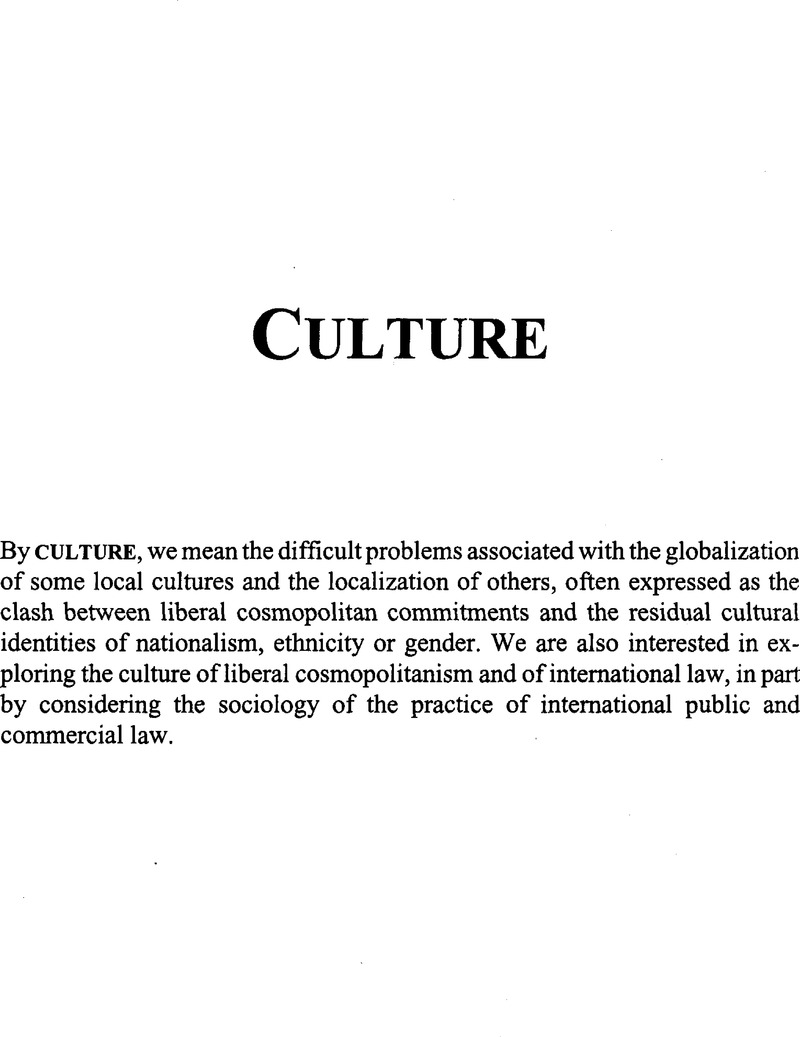Article contents
Superpower Attitudes Toward Indigenous Peoples and Group Rights
Published online by Cambridge University Press: 28 February 2017
Abstract

- Type
- Culture
- Information
- Copyright
- Copyright © American Society of International Law 1999
References
1 See, e.g., S. James Anaya, Indigenous Peoples in International Law (1996); Wiessner, Siegfried, The Rights and Status of Indigenous Peoples: A Global Comparative and International Legal Analysis, 12 Harv. Hum. Rts. J. 57 (1999)Google Scholar.
2 My assessment of the U.S. position is informed especially by the U.S. State Department’s statement to the last session of the working group of the UN Commission on Human Rights, which was established to consider a declaration on indigenous rights. See Leslie A. Gerson, Deputy Assistant Secretary of State, U.S. Department of State, General Statement, Commission on Human Rights Working Group on the Draft Declaration on the Rights of Indigenous People (Nov. 30, 1998).
3 Convention (No. 169) Concerning Indigenous and Tribal Peoples in Independent Countries, Geneva, International Labour Conference, June 27, 1989 (entered into force Sept. 5, 1991).
4 Draft UN Declaration on the Rights of Indigenous Peoples, as agreed upon by the members of the UN Working Group on Indigenous Populations at its eleventh session, Geneva, July 1993; adopted by the UN Sub-Commission on Prevention of Discrimination and Protection of Minorities by its resolution 1994/45, Aug. 26, 1994, UN Doc. E/CN.4/1995/2/, E/CN.4/Sub.2/1994/56, at 105 (1994).
5 Proposed American Declaration on the Rights of Indigenous Peoples, approved by the Inter-American Commission on Human Rights, Feb. 26, 1997, in: 1997 Inter-Am. C.H.R. Annual Report, OEA/ser.L/V/III.95.doc.7, rev. 1997, pp. 654-76. This proposed text was a revision of an earlier draft the Inter-American Commission had published in September 1995. See OEA/ser/L/V/II.90, doc. 9 rev. 1 (1995).
6 See Draft UN Declaration on the Rights of Indigenous Peoples, supra note 4, art. 3.
7 UN Charter art. 1(2); emphasis added.
8 International Covenant on Economic, Social and Cultural Rights, 993 U.N.T.S. 3, art 1(1); International Covenant on Civil and Political Rights, 999 U.N.T.S., art. 1(1).
9 See, e.g., Comm., H.R., General Comment 23, Article 27,Google Scholar HRI/GEN/1/Rev. 1 at 38 (1994) (referring to use of land resources by “indigenous peoples”); Concluding Observations of the Human Rights Committee: Canada, CCPR/C/79/Add. 105, at paras. 7,8 (1999) (regarding the rights of “aboriginal peoples” of Canada); “Committee on the Elimination of Discrimination, Racial, General Recommendation XXIII (51) concerning Indigenous Peoples, CERD/C/51/Misc.l3/Rev. 4 (1997)Google Scholar; Inter-Am. C.H.R., Report on the Human Rights Situation in Ecuador, OEA/Ser.L/V/II.96, at 99-106 (1997) (regarding the “collective land and other rights of indigenous peoples” of Ecuador).
10 See, e.g.. Council of Ministers of the European Union, Resolution on Indigenous Peoples within the Framework of the Development Cooperation of the Community and Member States, 214th Council meeting, Brussels, 30 Nov. 1998; European Parliament, Resolution on Action Required Internationally to Provide Effective Protection for Indigenous Peoples, Strasbourg, 9 Feb. 1994, Eur. Pari. Doc. PV 58(11) (1994).
1 See, e.g., S. Con. Res. 44, 103d Cong. (1993) (enacted), “to express the sense of the Congress concerning the International Yearofthe World’s Indigenous Peoples”; Exec. Order of June 7, 1999, Increasing Participation of Asian Americans and Pacific Islanders in Federal Programs.
12 Proposed American Declaration on the Rights of Indigenous Peoples, supra note 5, art. 1(1).
13 See generally Jones, Peter, Human Rights, Group Rights, and Peoples ‘ Rights, 21 Hum. Rts. Q. 80 (1999)CrossRefGoogle Scholar; Buchanan, Allen, The Role of Collective Rights in the Theory of Indigenous Peoples ‘ Rights, 3 Transnat’l L. & Contemp. Probs. 89 (1993)Google Scholar.
14 See Convention (No. 169) Concerning Indigenous and Tribal Peoples, supra note 3, art. 1 (3). “ See supra note 9.
16 See Wiessner, supra note 1 (surveying relevant legal developments throughout the world).
17 J.R. Crook, Office of the Legal Advisor, U.S. Department of State, Position Paper: “Draft Universal Declaration on Indigenous Peoples,” at 8, July 9, 1993.
18 Id.
1 Draft UN Declaration on the Rights of Indigenous Peoples, supra note 4, art. Hi.
20 See General Statement by Leslie A. Gerson, Deputy Assistant Secretary of State, supra note 2, at 3: “we do not believe that international law accords indigenous groups everywhere the right of self-determination.”
21 Reference re Secession of Quebec, [1998] 2 S.C.R. 217, para. 154.
22 For my own argument in this regard, see Anaya, supra note 1, at 75-96.
23 Canadian Statement to the UN Working Group on the Draft Declaration on the Rights of Indigenous Peoples, Oct. 31, 1996.
24 See U.S. Dep’t. of State, Civil and Political Rights in the United States: Initial Report of the United States of America to the U.N. Committee on Human Rights under the International Covenant on Civil and Political Rights, July 1994, at 36-46, Dep’t. of State Pub. 10200 (1994).
25 Concluding observations of the Human Rights Committee: Canada, supra note 9, para. 7.
26 Id., para. 8.
- 3
- Cited by




